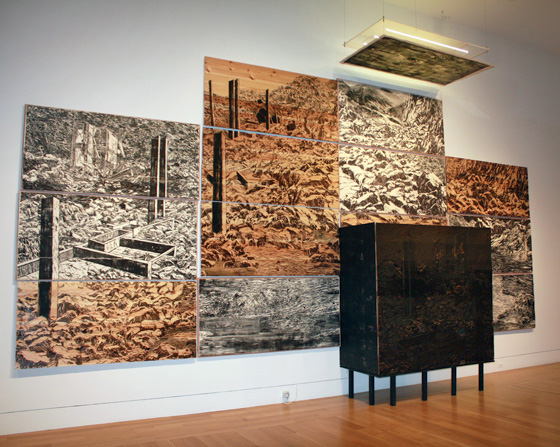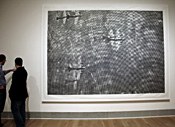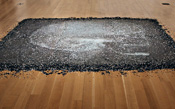This weekend my parents visited me for the first time since I started the MFA program. Both had been to Philadelphia before, but neither of them had spent so much time on the fringes of the academic art world.
The weekend started out with a visit to the Tyler Grad Thesis Shows at the Tower Gallery. I was excited that so many of my peers would be in one space at one time so my parents could meet them. That is where they were encountered by their first few instances of obstacles of understanding. Asking people what department they were in and then what there work was proved confusing. "I am in the photography department, but my work is sculptural." "I am a painter, but I am mostly making installation." "I am in the fiber department, but I mostly do soft sculpture." If everyone was doing sculpture, you can imagine their surprise to see that the sculpture MFA candidate in the exhibition showed two videos.
We talked to another sculpture grad about this at length. Vanessa said, "Yeah, the only one in our department who is really making traditional sculpture is Tim." It sounded like the rest of them were focusing on video.
Back at school when I guided my parents on a pretty good tour of the facilities, there were even more examples of the kind of art that Mr. and Mrs. Shealey just could not have expected. And upon finding the Wolgin bust, my stepfather said with some relief, "Now, this is sculpture."
True. My parents are NOT members of the art world, but they do not live underneath rocks, either. I think what they questioned is completely valid and one that we, in the middle of the ebb and flow of art discourse forget: why call something sculpture that is something else? Why not just call it video. (For example).
In the essay "Sculpture In the Expanded Field," Rosalind Krauss discusses how sculpture has morphed in the 1950s, 60s, and 70s. She uses diagrams to show how maybe sculpture should be freed from certain other artforms and they should have their own name: marked sites, site construction, and axiomatic structures. Including sculpture, these artforms are varying degrees of landscape and "not landscapes" and architecture and "not architecture." To be honest, these designations seem a bit dated to me and, if it is helpful, I am happy to have them included as viable alternatives to calling everything sculpture. But I don't think that they get to the heart of the issue--the heart that is still very much beating today.

Krauss, in the beginning of her essay, writes of the broadening definition of sculpture in 1979, "We had thought to use a universal category to authenticate a group of particulars, but the category has now been forced to cover such a heterogeneity that it is, itself, in danger of collapsing." I believe that renaming facets of art and various trends within art (like site constructions) do not solve the problem of this collapsing. And perhaps the collapsing is not the problem, but the inevitable sign of things to come.
Interdisciplinarity is what most contemporary artists want for themselves. One should not forget that the context of my story began in an art school environment where people have to apply to specific departments. But, once they are out in the world, away from the academy, they are not necessarily going to say "I am a photographer" if in fact they are mostly making sculpture.
That said, these words begin to lose some meaning over time if we allow the boundaries between disciplines to be so malleable. My suggestion is, however, that
the art should trump our concern for vocabulary and ability to discuss these things. Like Krauss says towards the end of her essay, our art lexicon is "organized instead through the universe of terms that are felt to be in opposition within a cultural situation" and that specific mediums do not matter so much. It is when we challenge the structure (in this case definitions) that we make the most interesting and progressive work. When you ask a Tyler grad, for example, what their deparment is and what there work is like, they are giving you answers that have to do with what is going on with their art practice right then, in that moment in time. They can use mediums to describe the situation, but ultimately, if they are like the majority of us, they cannot be defined even that rigidly longterm. They might be making sculptural altars today and will be painting tomorrow. Or maybe not painting.
It might make for more confusion with artists' parents, but I think they can handle it. And I think, by the end of the weekend with my parents, they were enjoying the play they could have in talking about art.

































